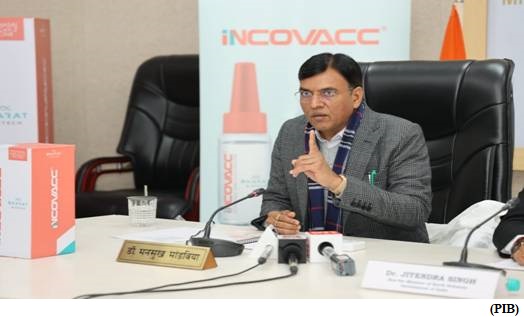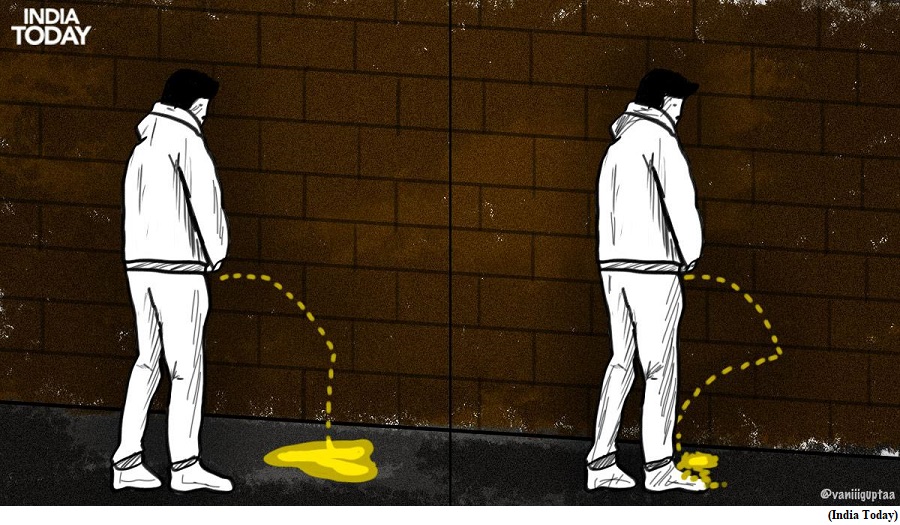Union Health Minister Dr. Mansukh Mandaviya unveils world’s first intranasal COVID19 vaccine, iNNCOVACC (GS Paper 2, Health)

Why in news?
- Recently, Dr. Mansukh Mandaviya, Union Minister of Health & Family Welfare unveiled the iNNCOVACC COVID19 vaccine.
About iNNCOVACC:
- iNNCOVACC is the world’s first intranasal COVID19 vaccine to receive approval for the primary 2-dose schedule, and as a heterologous booster dose.
- It is developed by Bharat Biotech International Limited (BBIL) in collaboration with Biotechnology Industry Research Assistance (BIRAC), a PSU under the Dept of Biotechnology, Ministry of Science and Technology.
Features:
- iNCOVACC is a cost effective covid vaccine which does not require syringes, needles, alcohol wipes, bandage, etc, saving costs related to procurement, distribution, storage, and biomedical waste disposal, that is routinely required for injectable vaccines.
- It utilizes a vector-based platform, which can be easily updated with emerging variants leading to large scale production, within a few months.
- These rapid response timelines combined with the ability of cost effective and easy intranasal delivery, makes it an ideal vaccine to address future infectious diseases.
ZyCoV-D:
- ZyCoV-D, the world’s first and India’s indigenously developed DNA based vaccine for Covid-19 to be administered in humans including children and adults 12 years and above, was also developed in partnership with the Department of Biotechnology in the Ministry of Science & Technology under ‘Mission Covid Suraksha’ through BIRAC.
India notifies Pakistan on “modification” of Indus Waters Treaty
(GS Paper 2, International Relation)
Why in news?
- In a significant development, India has cited Pakistan’s persistent objections regarding Kishenganga and Ratle hydropower projects in Kashmir and issued a notice to Pakisatn announcing “modification” of the 63-year-old Indus Waters Treaty (IWT).
- The notice was sent to Pakistan, through Commissioners for Indus Waters.

Objective:
- The objective of the notice for modification is to provide Pakistan an opportunity to initiate “intergovernmental negotiations” within 90 days regarding the differences that the Indian side has described as a “material breach”.
Background:
- It was argued that a dispute in the IWT has been brewing since 2015 when Pakistan asked for the appointment of a “Neutral Expert” to probe its “technical objections” to India’s Kishenganga and Ratle Hydro Electricity Projects.
- In 2016, Pakistan changed that request and proposed that a Court of Arbitration should examine the objections.
- In response, India sought the appointment of a Neutral Expert. The two processes would be contradictory and be “legally untenable”.
India’s response:
- The Indian side has alleged that by unilaterally changing the request from seeking a “Neutral Expert” to a “Court of Arbitration”, Pakistan has violated the Indus Waters Treaty which has been further complicated by the World Bank recently moving to act on both Neutral Expert and Court of Arbitration.
- Such parallel considerations on the same issues is not covered under any provision of IWT.
Indus Waters Treaty:
- The Indus Waters Treaty was signed in 1960 between India and Pakistan and is often cited as one of the most successful international treaties in South Asia which has endured wars and tension between India and Pakistan.
- The treaty lays down terms of distribution of the waters of the Indus and its tributaries that support agriculture and other economic activities of both north India and Pakistan.
- It allocated the three western rivers; Indus, Chenab and Jhelum to Pakistan for unrestricted use, barring certain non-consumptive, agricultural and domestic uses by India and the three Eastern Rivers; Ravi, Beas and Sutlej were allocated to India for unrestricted usage.
The science of pee-back paint: It is inspired from nature
(GS Paper 3, Science and Tech)
Why in news?
- Badly hit by the menace of public urination, London has a plan to deter people who are 'stenching' the city's reputation.
- Officials in Soho, a London area famous for bars, restaurants, theatres, and other entertainment venues are coating walls with unique paint.

Why unique?
- It splashes back the liquid thrown on it. The anti-pee paint creates a transparent water-repellent layer that splashes back urine when the layer comes in contact with the pee.
What is Anti-Pee Paint?
- The paint is mostly made up of acetone and silica with the major constituent being sand.
- The superhydrophobic coating keeps objects dry and is capable of repelling almost every liquid that is thrown on it.
- The paint uses an omniphobic technology to coat an object and create surface chemistry and texture with patterns of geometric shapes that have peaks or high points. These high points repel water, some oils, wet concrete, and other liquids.
Lotus effect:
- A 2015 study revealed that the lotus effect is attributed to a surface structure that is covered with needle-shaped wax tubes, and the remaining surface allows invasion of the water droplet and enlarges the interaction with water. The paint creates those high points.
- The coating is to be applied in two stages, with the first stage acting as a base primer. This primer smoothens the surface, making it hydrophobic after which the topcoat is applied.
- A hydrophobic surface does not allow liquid to stick to it, unlike a hydrophilic surface where water sticks.
- The paint repels dirty water and some oils, and remains clean and virtually bacteria-free.
Background:
- London is, however, not the first city to use this unique recipe of chemicals to deter public urinators.
- Cologne in Germany was the first to use this paint about seven years ago in 2015.




